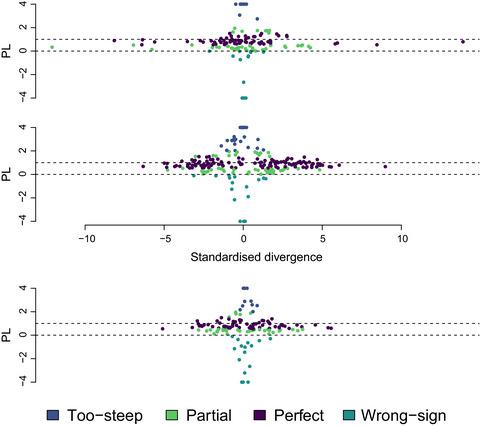当前位置:
X-MOL 学术
›
Ecol. Lett.
›
论文详情
Our official English website, www.x-mol.net, welcomes your
feedback! (Note: you will need to create a separate account there.)
The relative importance of plasticity versus genetic differentiation in explaining between population differences; a meta-analysis.
Ecology Letters ( IF 7.6 ) Pub Date : 2020-07-12 , DOI: 10.1111/ele.13565 Megan A Stamp 1 , Jarrod D Hadfield 1
Ecology Letters ( IF 7.6 ) Pub Date : 2020-07-12 , DOI: 10.1111/ele.13565 Megan A Stamp 1 , Jarrod D Hadfield 1
Affiliation

|
Both plasticity and genetic differentiation can contribute to phenotypic differences between populations. Using data on non‐fitness traits from reciprocal transplant studies, we show that approximately 60% of traits exhibit co‐gradient variation whereby genetic differences and plasticity‐induced differences between populations are the same sign. In these cases, plasticity is about twice as important as genetic differentiation in explaining phenotypic divergence. In contrast to fitness traits, the amount of genotype by environment interaction is small. Of the 40% of traits that exhibit counter‐gradient variation the majority seem to be hyperplastic whereby non‐native individuals express phenotypes that exceed those of native individuals. In about 20% of cases plasticity causes non‐native phenotypes to diverge from the native phenotype to a greater extent than if plasticity was absent, consistent with maladaptive plasticity. The degree to which genetic differentiation versus plasticity can explain phenotypic divergence varies a lot between species, but our proxies for motility and migration explain little of this variation.
中文翻译:

可塑性与遗传分化在解释种群差异之间的相对重要性;荟萃分析
可塑性和遗传分化都可导致种群之间的表型差异。使用来自相互移植研究的非适应性状数据,我们表明大约60%的性状表现出共同梯度变异,因此群体之间的遗传差异和可塑性诱导的差异是相同的征兆。在这些情况下,在解释表型差异时,可塑性大约是基因分化的两倍。与健身性状相反,环境相互作用引起的基因型数量很少。在表现出反梯度变异的40%的性状中,大多数似乎是增生的,因此非本地个体的表型超过了本地个体。在约20%的情况下,可塑性导致非本地表型与天然表型的差异要比不存在可塑性时更大,这与适应不良的可塑性一致。遗传分化与可塑性在多大程度上解释了表型差异,而物种之间的差异很大,但是我们关于运动和迁移的代理几乎不能解释这种差异。
更新日期:2020-07-12
中文翻译:

可塑性与遗传分化在解释种群差异之间的相对重要性;荟萃分析
可塑性和遗传分化都可导致种群之间的表型差异。使用来自相互移植研究的非适应性状数据,我们表明大约60%的性状表现出共同梯度变异,因此群体之间的遗传差异和可塑性诱导的差异是相同的征兆。在这些情况下,在解释表型差异时,可塑性大约是基因分化的两倍。与健身性状相反,环境相互作用引起的基因型数量很少。在表现出反梯度变异的40%的性状中,大多数似乎是增生的,因此非本地个体的表型超过了本地个体。在约20%的情况下,可塑性导致非本地表型与天然表型的差异要比不存在可塑性时更大,这与适应不良的可塑性一致。遗传分化与可塑性在多大程度上解释了表型差异,而物种之间的差异很大,但是我们关于运动和迁移的代理几乎不能解释这种差异。











































 京公网安备 11010802027423号
京公网安备 11010802027423号